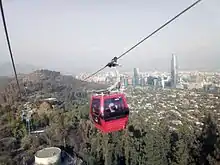Santiago Cable Car
The Santiago Cable Car (Spanish: Teleférico de Santiago) is a way of transport of a tourist nature, located at the Metropolitan Park of San Cristóbal Hill, in Santiago, Chile.
| Teleférico de Santiago | |
|---|---|
 View from the cable car (2016) | |
| Overview | |
| Status | Operational |
| Character | Aerial tramway |
| Location | San Cristóbal Hill, Santiago |
| Country | |
| Termini | Oasis station Cumbre station |
| No. of stations | 3 |
| Open | 1 April 1980 |
| Closed | 7 June 2009 |
| Reopened | 24 November 2016 |
| Operation | |
| Operator | Turistik |
| No. of carriers | 47 cabins |
| Carrier capacity | 6 passengers |
| Technical features | |
| Line length | 4.8 km (3.0 mi) |
| Operating speed | 18 km/h (11 mph) |
| Notes | Electric motor powering cable bullwheel |
History
First era (1980-2009)


The construction of the cable car began in 1979, and took about a year, mainly due to the hardness of the volcanic rock terrain in which the 12 towers were installed.[1]
The Santiago Cable Car was officially opened on April 1, 1980, with 72 ovoid-shaped cars, which covered the 20-minute 4.8 km section at 14.4 km/h.[2]
On December 12, 2008, a mechanical fault left 20 people trapped in the cable car for two hours, without registering any injuries.[3] Subsequently, on June 7, 2009, another mechanical failure occurred in the system: the gearbox that regulated the speed of the system exploded, which caused the indefinite suspension of the service.[4]
Second era (2016-present)
In 2011 a project was presented to tender the cable car, provide it with new cabins and restore the infrastructure. It was expected that in 2012 the service reopened the public,[5] nevertheless the Ministry of Housing and Urban Development received only one offer which it rejected, reason why it declared deserted the licitation and announced a new public contest,[6] that began in November 2013.[7]
In December 2014, it was announced that the cable car would be reopened in the second half of 2016, following a series of maintenance and remodeling works that began in March 2015 and will cost 9.5 million dollars.[8] These works included the installation of the new network of 47 cabins with capacity for six people each.[9]
.jpg.webp)
In January 2016, the Chilean Ministry of Housing and Urban Development launched a public competition for social and non-governmental organizations, neighborhood or municipal councils to submit projects to recover assets of the 56 cabins that were discontinued and which were part of the original system in 1980.[10] On July 29 of the same year the winning projects, which included libraries, recreational spaces, and a motorized train in Pueblito Las Vizcachas were presented at the Espacio Matta Cultural Center.[11]
The cable car was reopened on November 24, 2016 by President Michelle Bachelet.[12] Between December 14 and 16, the cable car closed temporarily due to its first maintenance operation after reaching 500 operating hours and receiving more than 68 thousand visits in 16 days.[13]
Characteristics

The new cable car has 47 cabins (16 red, 16 blue and 15 green) that can carry up to 6 people each, plus 8 cars designed exclusively to carry bicycles (four in each cart) and a maintenance trolley. Its speed varies between 1 and 5 meters per second (18 km/h).[2]
The system has three stations: Oasis, Tupahue and Cumbre. In the latter it connects with the Santiago Funicular. The Tupahue is located near the Tupahue Pool, the Mapulemu Botanical Garden ("Forest of the Earth") and the Camino Real Restaurant.
References
- "El cementerio de los "huevitos" del Teleférico". La Tercera (in Spanish). 8 November 2010. Retrieved 16 January 2012.
- "Teleférico de Santiago". El Mercurio (in Spanish). 7 November 2016. Retrieved 7 November 2016.
- "Por más de dos horas 20 personas estuvieron atrapadas en teleférico". La Tercera (in Spanish). 12 December 2008. Retrieved 16 January 2012.
- "Teleférico volverá a funcionar en septiembre de 2012 y anuncian mejoras en funicular". La Tercera (in Spanish). 7 July 2011. Retrieved 31 January 2016.
- "Presentan prototipo de las nuevas cabinas del teleférico del cerro San Cristóbal". La Tercera (in Spanish). 15 March 2011. Retrieved 16 January 2012.
- D. Zambra and E. Briceño (1 December 2012). "Declaran desierta licitación de teleférico San Cristóbal". La Tercera (in Spanish). Retrieved 3 January 2013.
- "Siete empresas están interesadas en la renovación del teleférico". La Tercera (in Spanish). 8 January 2014. Retrieved 5 November 2014.
- "Tras cinco años fuera de servicio, restablecerán teleférico del Cerro San Cristóbal". EMOL (in Spanish). 27 December 2014. Retrieved 5 January 2015.
- Manuel Valencia (20 April 2015). "En abril del próximo año debería estar funcionando el nuevo teleférico de Santiago". El Mercurio (in Spanish). Retrieved 20 April 2015.
- "Minvu lanza concurso para preservar cabinas del ex teleférico". La Tercera (in Spanish). 28 January 2016. Retrieved 31 January 2016.
- ""Huevitos" del antiguo teleférico del Parque Metropolitano ya tienen destino". EMOL (in Spanish). 29 July 2016. Retrieved 24 November 2016.
- "Reinauguran Teleférico del Parque Metropolitano de Santiago". La Tercera (in Spanish). 24 November 2016. Retrieved 24 November 2016.
- "A casi un mes de su apertura teleférico cierra por mantención". Ahora noticias (in Spanish). 14 December 2016. Retrieved 5 January 2017.
External links
| Wikimedia Commons has media related to Teleférico de Santiago. |